Interviews & Reports
"Forging On: The Art of Sakai Blacksmiths" Part 1A visit to Izumi Riki Seisakujo in Sakai, Osaka Japan
Laura Wheatley / Travel Photographer (words and photos by Laura Wheatley)
Forged knives have been sought after and revered worldwide for years, which, once you know the process involved, it's not hard to see why! Recently I ventured into the old blacksmith neighborhoods of Sakai to uncover this masterful art.
Engraved knives ready for shipment
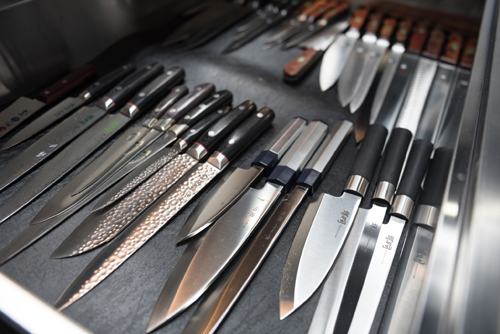
Although metalworking was introduced more than 1000 years ago, the city had begun to receive true acclaim around the mid-1500's. As a port city, Sakai frequently saw a great amount of trade. Tobacco and guns were popular, brought over from the Portuguese.
In order to smoke the tobacco in pipes the leaves needed to be finely cut. Local blacksmiths began developing such knives needed to cut with acute precision, therefore forging extremely sharp blades of high quality.
Through the eras Sakai continued to be at the forefront of metalworking, forging swords for samurai and beyond. As the Tokugawa shogunate fell from power, samurai stopped carrying swords and the demand for such transitioned to knives.
The prized art of these blacksmiths has been passed down through each generation. One such company that has been crafting these precious knives for eight generations is Izumi Riki Seisakujo of Sakai.
Established in 1805, Izumi Riki Seisakujo has been expertly crafting knives of the highest quality for professional chefs and home cooks all over Japan and worldwide for more than 200 years. The city's close proximity to the food mecca of Osaka has been integral in developing long-lasting superior knives. While their Sakai Tohji brand is highly successful, the company is also looking into new materials for their knives such as molybdenum steel and Damascus steel.
A knife made of Damascus steel
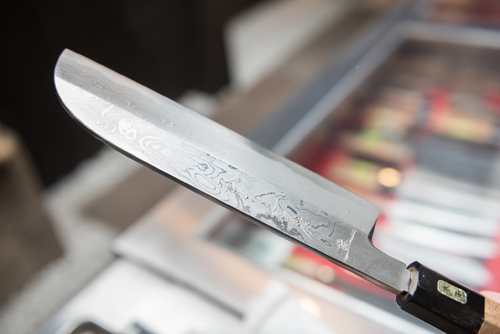
Many kitchen knives in the world today are made by a machine that stamps the shape of a knife out of a sheet of stainless steel, similar to a cookie cutter. These knives are marginally less durable and do not keep a sharp edge for long. Conversely, Sakai forged knives are known for their esteemed quality: in addition to having an extremely sharp edge, they are strong and durable due to the way in which they are forged and the materials used.
Japanese knives are lightweight and well-balanced, putting less strain on the wielder. To take a closer look into what makes Sakai knives superior and the blacksmithing process involved, I met with the seventh generation of Izumi Riki Seisakujo and Director of the Federation of Sakai Blades Commerce and Industry Association, Mr. Keizo Shinoda, at his company headquarters.
Various whetstones
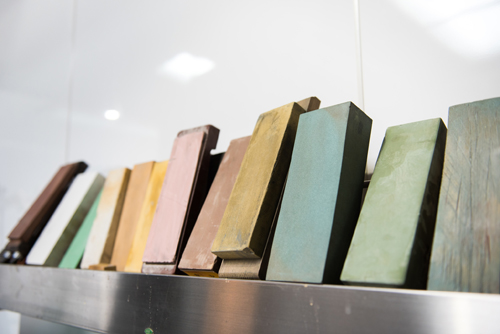
Mr. Shinoda honing
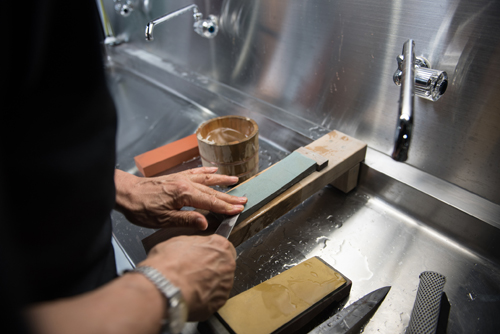
After introductions were made, Mr. Shinoda guided me through the Sakai Hamono Museum next door. I was fascinated to see older knives, gun, and swords from all over the world dated by era, as well as the terminology involved with the tools of the forging process. Next, at the sharpening studio, he expertly demonstrated the correct method of sharpening and honing Japanese forged knives on various grades of whetstones, and how each performed differently. Taking one of the knives he just honed, Mr. Shinoda held up a piece of paper and with his other hand he brought down the knife, slicing into it effortlessly - like butter. I couldn't help but smile in awe at the sharpness of the blade and the heavenly sound it made.
Mr. Shinoda slices paper with a knife just honed
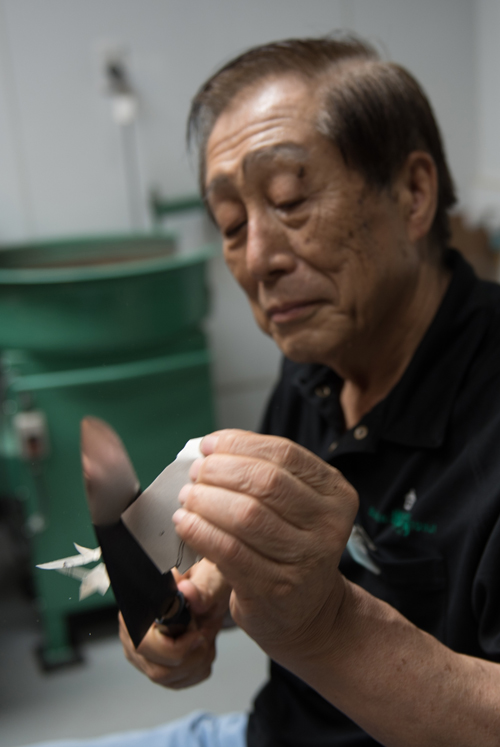
Paper sliced efforlessly

I was able to see various special knives laid out, gleaming in the light. Mr. Shinoda also showed me how the design of a Japanese forged knife compared in practicality and efficiency to other knives. After the whetstone demonstration we headed to another sector of Sakai to see where the forging is done.
Continued to "Forging On: The Art of Sakai Blacksmiths" Part 2




